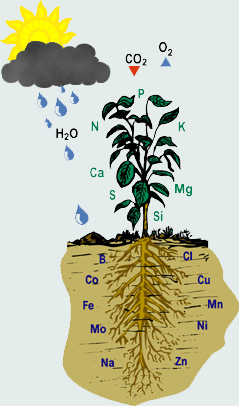Plant Nutrients Facts :

Nitrogen
Nitrogen has an important effect in cell division and vegetative growth, while in addition helps the absorption of the rest nutrients. Nitrogen is included in the structure a component of nucleic acids and chlorophyll. Therefore, nitrogen is a primary element of biosynthesis and plays a vital role at plant bioprocesses.Nitrogen deficiency usually results in limited plant development and yellowing or necrosis of lower and older leaves.
Symptoms of nitrogen deficiency:
All forms of nitrogen are agile in plants. So, symptoms of nitrogen \ deficiency are first evident at older leaves. Under nitrogen restriction plants are feebly and grow slowly. Leaves are small, their colour is light green to yellow, and older leaves fall prematurely rather frequently. If lack of nitrogen persists, foliage will continue to grow but shoots will become thin and soft and plants will be prone to diseases. Necrosis of the leaves or at least a part of them happens in a later and intense stadium of deficiency.
Phosphorus :
Phosphorus is an important nutrient for plants, necessary for energy transfer and therefore necessary at the most intensive phases of plant development: the development of the root system and the creation and development of flowers and fruits consecutively. Consequently, it directly affects and in large scale plant health and harvested crop. Although as known phoshporus is flexible in plants, it is cumbersome in the soil. For this reason any application of phoshporus fertilizationcombined with other less soluble products proves minimal direct effectiveness, since phosphorus will be attributed with passage of time to the next cultivation cycles.
Symptoms of phoshprus deficiency:
Phosphorus deficiency causes an abnormal development of the roots in plants, which results in a limited growth of foliage and an early defoliation. Older leaves often show chlorosis between the nerves, while younger leaves show a scarlet discouloration, which can reach even to their stems. Finally, phosphorus deficiency mainly causes reduced flowering and fruition or delays fruit ripening.
Potassium :
Potassium plays an important role in carbohydrate metabolism and particularly in composition and disintegration of amyl. It is also an enzyme activator and is necessary for the increase of meristems. Additionally, potassium adjusts the opening and closing of stomation, as well as the plant's water relations. Finally, it improves the quality of fruits and increases the resistance of the plant to diseases. Potassium deficiency lowers photosynthesis and augments breathing and concentration of non-protein nitrogen.
Symptoms of phoshprus deficiency:
The visible symptoms of potassium deficiency in plants vary, depending on its intensity. Leaves acquire dark green or aquamarine colour. Necrotic spots are observed at the tops in the section between the ribs of the lamina. Necroses are more distinguishable at the margin of leaves and in acute cases the margin torns. Also, excessive potassium deficiency results in necrosis of apical or oblique eyes.
Magnesium :
Magnesium is a basic building block of chlorophyll. It plays a primary role in the process of photosynthesis and consequently, most of the plant functions. Additionally, it is an activator of enzymes that take part in the proccesses of breathing, photosynthesis and nucleic acids' composition. It participates in phosphorus metabolism as a carrier of phosphorus compounds. It facilitates the transfer of carbohydrates and propels the composition of oils and fats. Magnesium is very flexible in plants and deficiencies are evident in old leaves with the form of irregular chlorosis. Great deficiency of the element causes suspension of development.
Symptoms of magnesium deficiency :
When there is a deficiency in magnesium, leaves turn yellow (ochre) because of the reducing of chlorophyll. Symptoms initially appear at the margins of leaves and then expand in the areas between the nerves of leaves, especially the lower and older ones. This symptom distinguishes magnesium deficiency from iron chlorosis, which usually starts from young leaves. At last, the tissue of infected leaves becomes brown.
Calcium :
Calcium is necessary for the division and elongation of the cells. It regulates the intake of K, Mg, Na and activates certain enzymes. Its key role however is the consolidation of cellular structures. It strengthens cell walls and increases their plasticity. It limits physiological abnormalities of fruits and icreases their durability against fungal and bacterial attacks, especially during their preservation in freezers. This is how their maintainability increases. It doesn't move easily within plants and this is the reason its deficiencies become evident at the rapidly growing parts of the plants (young leaves and fruits). So, although it is usually found in abundance in the soil, calcium deficiencies are very often observed, that's why the supply of plants must be continuous and complemented with foliar application. Calcium deficiencies worsen during drought terms, as well as during periods of heavy rainfall, because of calcium washout. It appears more at large fruits and high production levels. Application of great quantities of organic fertilizers, as well as excessive fertilizations with nitrogen and potassium (high relative N/Ca, K/Ca) exacerbates the problem. Some crops or even varieties show greater sensitivity.
Symptoms of magnesium deficiency :
Calcium deficiency causes contortion of young leaves. The rising edges become stunted and it is possible that yellow or brown areas will develop along the peripheries of leaves or between the nerves.

